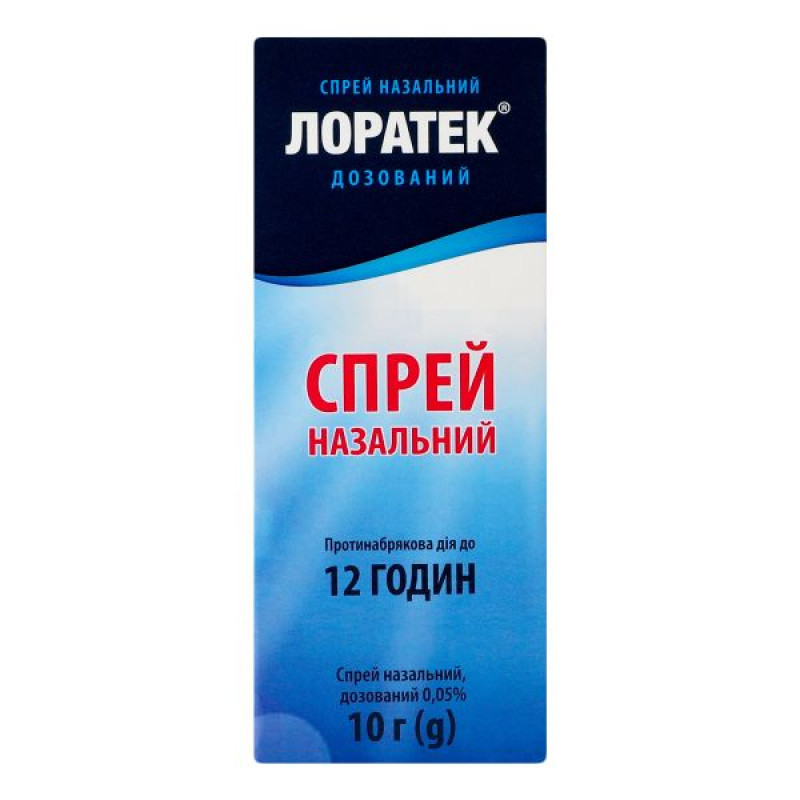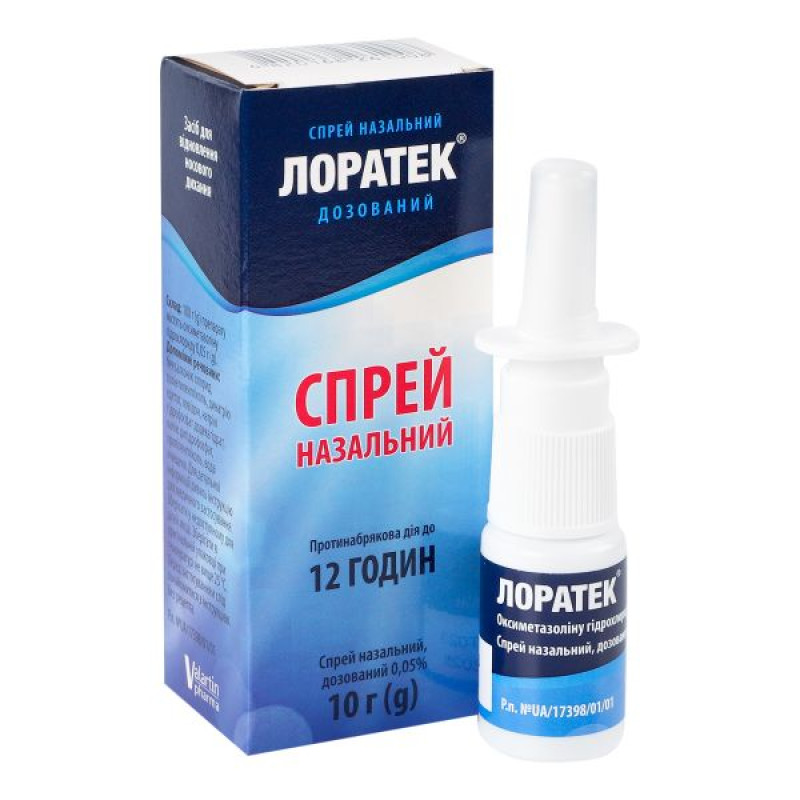Loratec nasal spray 0.05% 10 ml

Instructions for Loratec nasal spray 0.05% 10 ml
Composition
active ingredient: oxymetazoline hydrochloride;
100 g of the drug contain oxymetazoline hydrochloride, calculated as 100% substance, 0.05 g;
other ingredients: benzalkonium chloride, polyethylene glycol, disodium edetate, propylene glycol, povidone, sodium hydrogen phosphate dodecahydrate, potassium dihydrogen phosphate, purified water.
Dosage form
Nasal spray, metered.
Main physicochemical properties: the drug is sprayed in the form of an aerosol jet, which is liquid particles dispersed in the air.
Pharmacotherapeutic group
Anti-edematous and other drugs for local use in diseases of the nasal cavity. Sympathomimetics, simple drugs. Oxymetazoline. ATX code R01A A05.
Pharmacological properties
Pharmacodynamics
Oxymetazoline hydrochloride is a synthetic adrenomimetic. Stimulating α-adrenoreceptors of blood vessels, it contributes to a pronounced and long-lasting vasoconstrictor effect. The vasoconstrictor effect is manifested by a decrease in blood flow, a decrease in swelling of the mucous membranes of the nose, paranasal sinuses and Eustachian tube, as a result of which nasal breathing, which was disturbed during the flu, colds and allergic diseases, is restored.
Local vasoconstriction of the nasal mucosa and paranasal sinuses occurs 5-10 minutes after injection of the drug into the nasal cavity. The anti-edema effect lasts up to 12 hours. The drug has a softening effect on the irritated nasal mucosa and protects it from excessive drying.
Pharmacokinetics
The half-life is 5-8 hours. It is excreted mostly unchanged in urine and feces.
Indication
Symptomatic treatment of colds, flu, allergic diseases (hay fever), accompanied by acute rhinitis, sinusitis, other sinusitis (frontitis, ethmoiditis); treatment of acute otitis media
Contraindication
Increased individual sensitivity to oxymetazoline, other adrenomimetics or to any components of the drug, severe forms of arterial hypertension, pronounced atherosclerosis, acute cardiovascular diseases or cardiac asthma, tachysystolic heart rhythm disorders, angina pectoris, renal a, metabolic disorders (hyperthyroidism, diabetes mellitus), atrophic rhinitis, increased intraocular pressure, especially in angle-closure glaucoma, after transsphenoidal hypophysectomy or other surgical intervention with opening the dura mater; inflammation or damage to the skin of the paranasal passages or nasal mucosa; use of drugs that contribute to an increase in blood pressure; simultaneous use with monoamine oxidase inhibitors (MAO) and use within 2 weeks after discontinuation of treatment with MAO inhibitors.
Interaction with other medicinal products and other types of interactions
When using other medications, it is recommended to consult a doctor before starting treatment. Use of the drug together with other vasoconstrictors (by any route of administration) or other nasal decongestants, as well as with tricyclic antidepressants, maprotiline, should be done after consulting a doctor, as an increase in blood pressure is possible.
Concomitant use of MAO inhibitors and oxymetazoline may increase blood pressure. Therefore, this drug should not be used simultaneously with or within 2 weeks of stopping treatment with MAO inhibitors.
With simultaneous use of oxymetazoline with tricyclic antidepressants, an increase in blood pressure and the occurrence of arrhythmia are possible.
Oxymetazoline may reduce the effectiveness of β-blockers, methyldopa, or other antihypertensive drugs.
With the simultaneous use of sympathomimetics and antiparkinsonian agents, an additive toxic effect on the cardiovascular system is possible.
Application features
When spraying into the nasal cavity, do not tilt your head or turn the bottle over. It is not recommended to use one bottle for several people to avoid spreading the infection.
Persistent swelling of the nasal passages after the third day of use may indicate the presence of a deviated nasal septum, purulent sinusitis, adenoids, allergic rhinitis, persistent bacterial infection, or other unrecognized diseases that require a doctor's consultation and specialized complex therapy.
You should consult a doctor before using the drug in the following cases: high blood pressure, cardiovascular disease, liver or kidney disorders, porphyria.
Prolonged use and overdose of the drug should be avoided. Prolonged use of the decongestant may lead to a weakening of its effect. Abuse of this drug may cause mucosal atrophy and reactive hyperemia with rhinitis medicamentosa, as well as damage to the mucosal epithelium and inhibition of epithelial activity. Doses higher than recommended should be used only under the supervision of a physician. The recommended dosage should not be exceeded.
The product contains propylene glycol and benzalkonium chloride, which may cause skin reactions.
Ability to influence reaction speed when driving vehicles or other mechanisms
After prolonged use of the drug in doses exceeding the recommended ones, a general effect on the cardiovascular system cannot be excluded. In such cases, the ability to drive may be impaired.
Use during pregnancy or breastfeeding
Oxymetazoline has not been associated with adverse pregnancy outcomes. It should be used with caution in patients with hypertension or signs of reduced placental blood flow. Frequent or prolonged use of high doses may lead to reduced placental blood flow. The drug should be used in pregnant women only if, in the opinion of the physician, the benefit to the mother outweighs the potential risk to the fetus/child.
It is not known whether oxymetazoline passes into breast milk. Due to the lack of data, oxymetazoline should not be used during breastfeeding.
Method of administration and doses
Adults and children over 12 years of age should be given 2 sprays, children from 6 to 12 years of age should be given 1 spray in each nostril. The bottle should be held vertically. Repeat the spray no earlier than after 12 hours.
Duration of treatment - no more than 3 days. Long-term use is possible up to 7-10 days, 2 injections per day under the supervision of a doctor.
Children
Should not be used in children under 6 years of age.
Overdose
With topical application, systemic adverse reactions usually do not occur.
Symptoms of oxymetazoline overdose are different. There are stages of hyperreactivity and inhibition. Stimulation of the central nervous system is clinically manifested by feelings of fear, excitement, hallucinations, and seizures.
Symptoms of moderate or severe overdose include miosis (narrowing of the pupils), mydriasis (dilation of the pupils), nausea, vomiting, cyanosis, fever, sweating, cramps, tachycardia, arrhythmia, cardiac arrest, increased blood pressure, and pulmonary edema.
Suppression of central nervous system functions is clinically manifested as drowsiness, decreased body temperature, bradycardia, hypotension, collapse, shock, respiratory disorders and respiratory arrest, loss of consciousness, coma.
Clinical manifestations of overdose in children include central nervous system (CNS) symptoms: seizures and coma, hallucinations, bradycardia, apnea, variable hypotension and hypertension.
Emergency care. In case of suspected overdose with oxymetazoline, urgent hospitalization in the intensive care unit is necessary. Activated charcoal and laxatives should be prescribed. Gastric lavage is necessary. β-blockers (phentolamine) should be prescribed to reduce high blood pressure. Vasopressors should not be taken. Anticonvulsant therapy is indicated if necessary. In severe cases, intubation and artificial ventilation of the lungs may be necessary.
Adverse reactions
With frequent and prolonged use, a burning sensation, tingling in the nose, flushing, sneezing, and dryness of the mucous membrane may occur. Rarely, after the effect of the drug wears off, a feeling of severe nasal congestion (reactive hyperemia) may occur. Long-term continuous use of vasoconstrictor drugs may lead to tachyphylaxis or the development of rhinitis medicamentosa. In general, no serious side effects are expected.
From the cardiovascular system: Very rarely, tachycardia, palpitations, increased blood pressure, and heart pain are possible.
On the part of the organs of vision. Rarely, irritation, discomfort or redness of the eyes, blurred vision may occur.
Gastrointestinal: Nausea may occur rarely.
On the part of the immune system: In rare cases, hypersensitivity reactions are possible, including rash, itching, angioedema.
Respiratory, thoracic and mediastinal disorders: Discomfort or irritation of the nose, mouth and throat, as well as epistaxis, may occur rarely.
Nervous system: Anxiety, nervousness, restlessness, insomnia, drowsiness, tremor, hallucinations (especially in children), increased fatigue, headache, dizziness.
Skin and subcutaneous tissue disorders: Rash.
Musculoskeletal and connective tissue disorders: Convulsions (especially in children).
General disorders: Weakness.
Expiration date
2 years.
Storage conditions
Store in original packaging at a temperature not exceeding 25 ° C. Keep out of the reach of children.
Packaging
10 g in a bottle with a sprayer. 1 bottle in a pack.
Vacation category
Without a prescription.
Producer
LLC "Micropharm".
Location of the manufacturer and its business address
Ukraine, 61013, Kharkiv, Shevchenko St., 20.
There are no reviews for this product.
There are no reviews for this product, be the first to leave your review.
No questions about this product, be the first and ask your question.



